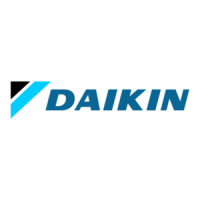REFRIGERANT PIPING WORK
See the installation manual supplied with the outdoor unit.
1. FLARING THE PIPE END
1) Cut the pipe end with a pipe cutter.
2) Remove burrs with the cut surface facing downward
so that the chips do not enter the pipe.
3) Put the flare nut on the pipe.
4) Flare the pipe.
5) Check that the flaring is properly made.
Warning
Do not use mineral oil on flared part.
Prevent mineral oil from getting into the system as this would reduce the lifetime of the units.
Never use piping which has been used for previous installations. Only use parts which are delivered with the unit.
Do never install a drier to this R410A unit in order to guarantee its lifetime.
The drying material may dissolve and damage the system.
Incomplete flaring may cause refrigerant gas leakage.
2. REFRIGERANT PIPING
1) To prevent gas leakage, apply refrigeration machine oil on both inner
and outer surfaces of the flare. (Use refrigeration oil for R410A)
2) Align the centres of both flares and tighten the flare nuts 3 or 4
turns by hand. Then tighten them fully with the torque wrenches.
• Use torque wrenches when tightening the flare nuts to prevent
damage to the flare nuts and escaping gas.
Caution
Overtightening may damage the flare and cause leaks.
3) After the work is finished, make sure to check that there is no
gas leak.
4) After checking for gas leaks, be sure to insulate the pipe connections.
• Insulate using the insulation for fitting included with the liquid and gas pipes. Besides, make sure the insulation for fitting
on the liquid and gas piping has its seams facing up.
(Tighten both edges with clamp.)
• For the gas piping, wrap the medium sealing pad over the insulation for fitting (flare nut part).
A
A
(Cut exactly at right angles.) Remove burrs
Flare’s inner surface
must be flaw-free.
The pipe end must
be evenly flared in a
perfect circle.
Make sure that the
flare nut is fitted.
Check
0-0.02in 0.04-0.06in 0.06-0.08in
Set exactly at the position shown below.
Clutch-type
Flare tool for R410A
Clutch-type (Rigid-type)
Wing-nut type (Imperial-type)
Conventional flare tool
Flaring
Die
Gas pipe
Liquid pipe
Piping insulation
material (main unit)
Attach to base
Flare nut connection
Turn seams up
Insulation for fitting
(accessory)
Clamp
Piping insulation material
(Field supplied)
Gas Piping Insulation Procedure
(accessory)
Main unit
Clamp (accessory)
Flare nut connection
Turn seams up
Piping insulation material
(Field supplied)
Piping insulation
material (main unit)
Attach to base
Main unit
Insulation for fitting
(accessory)
Liquid Piping Insulation Procedure
Small sealing pad
Measure the length of the gas
pipe as you will have to cover
it with the sealing tape.
(accessory)
Wrap the sealing
tape around the
gas pipe.
Main unit

